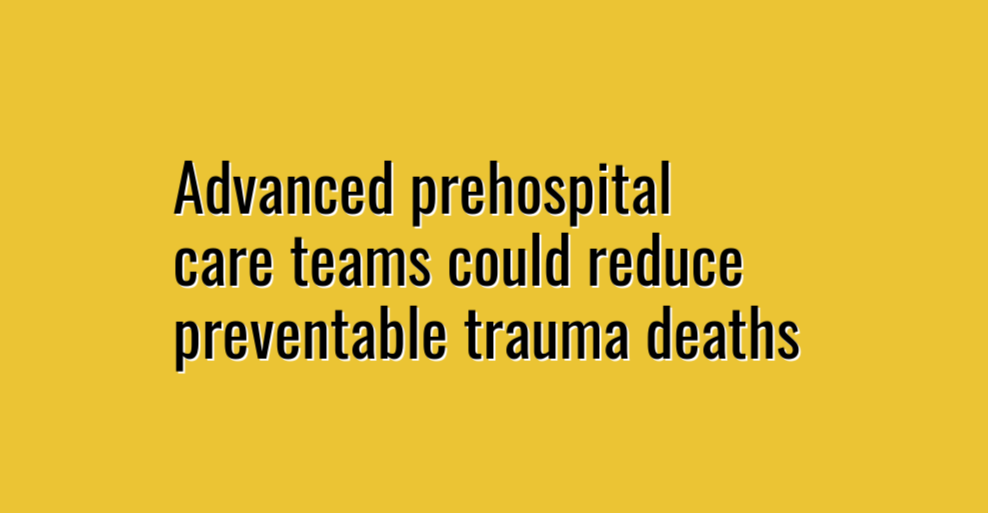Severely injured patients have a better chance of survival than ever before — if they make it to a trauma center. However, a significant percentage of patients with difficult-to-control bleeding still die in the field or en route to a hospital. Recently, a group of civilian and military trauma leaders proposed a new strategy for decreasing preventable prehospital death — deploying advanced care teams closer to the point of injury (POI).
The group described their proposal in an article published ahead of print in Shock. Their idea is to develop multidisciplinary clinical teams capable of providing advanced resuscitation and critical care at the POI and during transportation to definitive care.
The authors of the paper call these units Selective Prehospital Advanced Resuscitative Care (SPARC) teams. The target population is patients with noncompressible torso hemorrhage, a leading cause of preventable death.
Based on several models
According to lead author Zaffer Qasim, MD, FRCEM, EDIC, the SPARC team proposal is rooted in the landmark Zero Preventable Deaths report developed by the National Academies of Sciences, Engineering and Medicine (NASEM).

“The NASEM report showed that about 20 percent of prehospital deaths are potentially preventable,” Dr. Qasim said. “But when you look through more recent work that’s come out, you see that the percentages can vary from 20 percent up to, in some areas, 40 percent. So it’s a significant burden of potentially preventable death that is due to torso hemorrhage, and we really haven’t yet found a great way to move forward in terms of improving these outcomes.”
The SPARC team strategy is based in part on military models for delivering advanced critical care near the battlefield and during evacuation. In the civilian setting, advanced care teams for severe injury have been established in London and Paris and mobile ECMO teams have been deployed in Minneapolis.
A team would include experienced clinicians, and it may or may not be led by a physician. Interventions could include advanced airway management techniques, blood product transfusion (including the use of whole blood), chest decompression, IV and IO access, and resuscitative endovascular balloon occlusion of the aorta (REBOA).
SPARC teams would also provide advanced critical care. “For example, for a patient with a severe head injury or for someone who’s profoundly hypotensive, an experienced team could provide more nuanced critical care en route than what can be provided by current paramedic capability,” Dr. Qasim said.
“The key to success for this strategy — as evidenced in both military and civilian settings — is early deployment,” Dr. Qasim said. “This requires dispatch centers and trauma systems to develop specific criteria for early team activation.”
Urban and rural applications
Dr. Qasim said the SPARC team strategy could be useful in rural settings, where small trauma centers do not have the capability to treat more complex injuries and transport times to definitive care are extended. However, the concept could also be implemented in urban areas.
“People think that in urban settings you usually have pretty short transport times,” Dr. Qasim said. “But then you look at cities like Houston, for example, where the traffic is so terrible that even ambulances trying to get into the trauma center are often snarled up in traffic.”
Theoretically, a SPARC strategy could include several response vehicles that are staged in different parts of an urban area. “When you look at the Minneapolis model for ECMO, they have cars staged at three or four different parts of the city so they are close to the hospitals they eventually take the patient to.”
How often would a SPARC team deploy? “It would vary from population area to population area in different trauma systems,” Dr. Qasim said. “In part, it depends on the volume of that particular area. When you look at London, for example, they have anywhere from three to eight flights a day. But when you look at some other services, they might have just one flight a day to address that area’s needs.”
System-based initiative
Trauma systems that are considering a SPARC strategy should begin by conducting a needs assessment.
“The first step is to have some data to back up the need,” Dr. Qasim said. “How many patients are there in your trauma system who suffer a noncompressible torso hemorrhage and who die before they reach the hospital or very soon upon arriving to the hospital?” He recommends the use of autopsy data to validate determinations of preventable mortality.
Once the data is in place, work on building a community coalition. “You need to talk to the relevant stakeholders, which include your trauma community, your emergency medicine community, the prehospital community including the medical director for your EMS system, and then other allied specialties like your blood bank,” Dr. Qasim said.
While the SPARC team model is ambitious, Dr. Qasim thinks it is achievable.
“We’ve done a great job in improving mortality in the hospital, but we haven’t really improved outcomes in the prehospital setting,” Dr. Qasim said. “So what I would like people to take away is that we need to look at this in a different manner, because what we’ve been doing so far has not been working very well for this subset of patients.”
“There is a significant burden associated with young, otherwise healthy people dying from non-compressible torso hemorrhage,” Dr. Qasim said. “And we owe it as a trauma community to think of ways we can improve these outcomes.”

